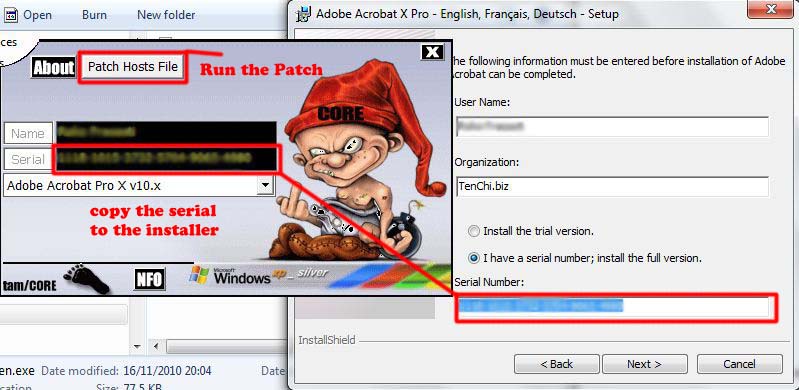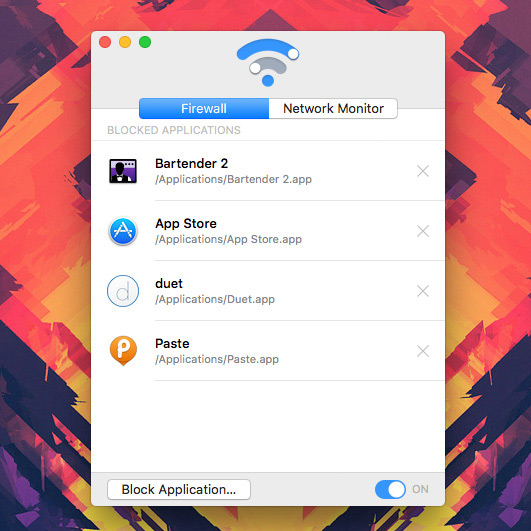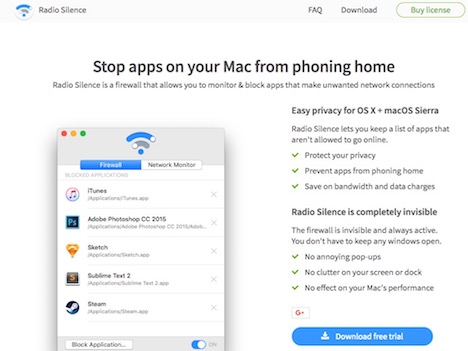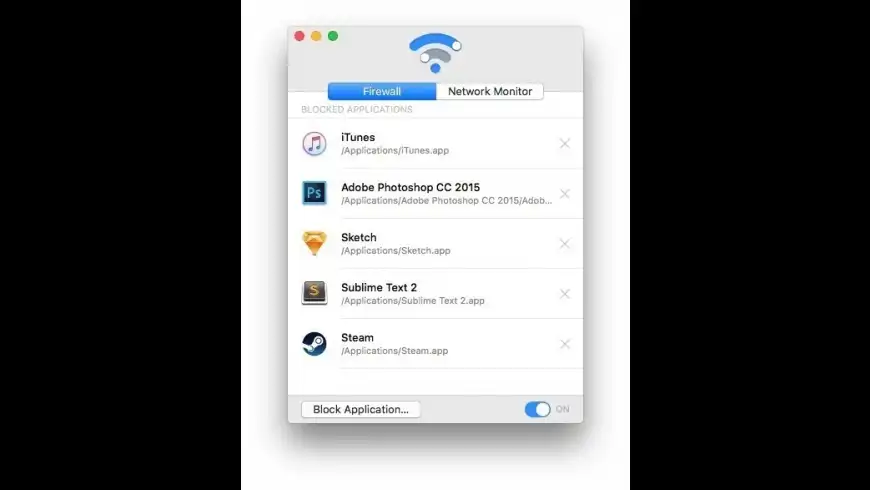Directed by Philippe Gagnon. With Georgina Haig, John Ralston, Carrie-Lynn Neales, Marc Senior. Relationship Therapist, Dr. Jill Peterman, had the highest-rated call-in radio show when her world was pulled out from under her following the on-air suicide of a female caller named Alexis. Shaken to her core, Dr. Jill walked away from her show vowing she would never go back. That is until Stuart. Trusted Mac download Radio Silence 2.3. Virus-free and 100% clean download. Get Radio Silence alternative downloads. Jan 03, 2020 Radio Silence is a tiny firewall that lets you block any application from accessing the internet. It is designed for people who are not interested in configuring traditional firewalls. Radio Silence supports OS X Yosemite, Mavericks, Mountain Lion, Lion, and Snow Leopard. It only takes a few seconds to install.
Radio Silence runs automatically when you start your Mac, so the only time you need to actually open its window is when you want to silence or un-silence specific apps. Apps are silenced as soon as. Mac: A lot of apps secretly check in with the mothership behind the scenes without asking your permission. If you'd prefer they didn't, Radio Silence can solve your problem hassle-free.
See all network connections — block any app from going online
Powerful privacy for your Mac, usable by anyone
Radio Silence lets you keep a list of apps that aren't allowed to make network connections.
- Protect your privacy
- Prevent apps from phoning home
- Save on bandwidth and data charges
Radio Silence is completely invisible
The firewall is invisible and always active. You don't have to keep any windows open.
- No annoying pop-ups
- No clutter on your screen or dock
- No effect on your Mac's performance
Safe 30-day guarantee: If you're not 100% happy, you get your money back. No questions asked.
Works with macOS 10.10 and newer, including Catalina. Support for Big Sur coming soon.
I was just listening to the most recent Security Now Podcast episode 83 wherein Steve Gibson goes to pains to describe what it takes on Windows to turn off your wireless hardware. Here's an excerpt from the transcript:

STEVE: Believe or not, yes. We've basically snuck in an entire show on maintaining full radio silence on Windows WiFi.
LEO: Well, it started when we were talking about this Free Public Wi-Fi that pops up on Windows from time to time, and what it was, and how now Microsoft has offered a fix but never told anybody about it, and you have to explicitly download it. That's what we talked about last week. And if you didn't hear last week's episode, you should absolutely download that update.
STEVE: Right. So that was our second mention. Then the week before, Episode 81, we talked about – we actually showed the dialogues required to turn off the functionality, just sort of this promiscuous connect-to-anything-that-I-hear, and also this idea of broadcasting the names of any networks you had connected to before, which by default Windows tries to do. It turns out that it's trying to do that still, even after you've got the update, because Microsoft added a checkbox to one of the configuration dialogues which is checked by default, and you have to go turn it off. So here in our fourth serialized How to Get Wi-Fi Just to Shut Up, we have additional instructions. People can, if they go to the show notes for this Episode 83, I've got a link back to the new and enhanced instructions that are over now on Episode 81's notes. So Episode 81's show notes are enhanced with this additional information, and this episode links back to those.
LEO: So this is if you installed the patch that Microsoft offered in November to fix wireless zero config, it's still promiscuous unless you uncheck this box.
STEVE: Yes. There's a box which enables it to connect to networks which are not broadcasting. And so if the networks are not broadcasting, then your computer does. And it's just like, okay...
LEO: Is this ad hoc only? Or is it infrastructure networks, as well?
STEVE: It's both. And so anyway, the idea is – in fact, I realized, okay, I started using the term 'maintaining full radio silence.'
LEO: Yeah, that's a good way to talk about it, yeah.
STEVE: As the famous jargon. And that's what we want. We want to be able to carry a laptop around. If we forget to disable our Wi-Fi, we don't want it sending out stuff of any sort. We want full radio silence. And so it turns out that following the instructions that are now on the show notes for 81, with the update which we talked about in 82, which we're all pulling together now in 83, when we first opened the topic in 80, we basically snuck in a whole Security Now! episode on maintaining full radio silence.'
Here's a link instructions to the instructions from Security Now:
For details on 'Maintaining Full Radio Silence' from Windows WiFi systems, please see the updated show notes for episode #81. They assume (and require) that the system has been updated with the Wireless Client Update for XP as described in episode #82 and notes.
If it's not clear, the step by step instructions for how to turn off WiFi are located at http://www.grc.com/sn/notes-081.htm
Radio Silence Mac Serial Number

Because Steve didn't mention how to do this on the Mac, I think I'll take the liberty of providing a comprehensive guide complete with pictures, so you can follow along. This guide applies to at least the last 3 versions of Mac OS X. Here goes:
Mac Serial Box
Step 1: Click the Airport Menu
Radio Silence Mac Serial Internet Download Manager
Step 2: Select Turn AirPort Off

Steve was talking mostly about WiFi radio emissions, but since most Macs have Bluetooth these days, I thought I'd go a step further and document how to turn off Bluetooth radio emissions as well.
Step 1: Click the Bluetooth Menu

Step 2: Select Turn Bluetooth Off
In conclusion, if you are ever responsible for designing the 'turn it off' use case, please consider the above mentioned comparison before completing your design.
Update 1: As a companion article, Joel Spolsky talks about the trials of turning off Windows Vista.

STEVE: Believe or not, yes. We've basically snuck in an entire show on maintaining full radio silence on Windows WiFi.
LEO: Well, it started when we were talking about this Free Public Wi-Fi that pops up on Windows from time to time, and what it was, and how now Microsoft has offered a fix but never told anybody about it, and you have to explicitly download it. That's what we talked about last week. And if you didn't hear last week's episode, you should absolutely download that update.
STEVE: Right. So that was our second mention. Then the week before, Episode 81, we talked about – we actually showed the dialogues required to turn off the functionality, just sort of this promiscuous connect-to-anything-that-I-hear, and also this idea of broadcasting the names of any networks you had connected to before, which by default Windows tries to do. It turns out that it's trying to do that still, even after you've got the update, because Microsoft added a checkbox to one of the configuration dialogues which is checked by default, and you have to go turn it off. So here in our fourth serialized How to Get Wi-Fi Just to Shut Up, we have additional instructions. People can, if they go to the show notes for this Episode 83, I've got a link back to the new and enhanced instructions that are over now on Episode 81's notes. So Episode 81's show notes are enhanced with this additional information, and this episode links back to those.
LEO: So this is if you installed the patch that Microsoft offered in November to fix wireless zero config, it's still promiscuous unless you uncheck this box.
STEVE: Yes. There's a box which enables it to connect to networks which are not broadcasting. And so if the networks are not broadcasting, then your computer does. And it's just like, okay...
LEO: Is this ad hoc only? Or is it infrastructure networks, as well?
STEVE: It's both. And so anyway, the idea is – in fact, I realized, okay, I started using the term 'maintaining full radio silence.'
LEO: Yeah, that's a good way to talk about it, yeah.
STEVE: As the famous jargon. And that's what we want. We want to be able to carry a laptop around. If we forget to disable our Wi-Fi, we don't want it sending out stuff of any sort. We want full radio silence. And so it turns out that following the instructions that are now on the show notes for 81, with the update which we talked about in 82, which we're all pulling together now in 83, when we first opened the topic in 80, we basically snuck in a whole Security Now! episode on maintaining full radio silence.'
Here's a link instructions to the instructions from Security Now:
For details on 'Maintaining Full Radio Silence' from Windows WiFi systems, please see the updated show notes for episode #81. They assume (and require) that the system has been updated with the Wireless Client Update for XP as described in episode #82 and notes.
If it's not clear, the step by step instructions for how to turn off WiFi are located at http://www.grc.com/sn/notes-081.htm
Radio Silence Mac Serial Number
Because Steve didn't mention how to do this on the Mac, I think I'll take the liberty of providing a comprehensive guide complete with pictures, so you can follow along. This guide applies to at least the last 3 versions of Mac OS X. Here goes:
Mac Serial Box
Step 1: Click the Airport Menu
Radio Silence Mac Serial Internet Download Manager
Step 2: Select Turn AirPort Off
Steve was talking mostly about WiFi radio emissions, but since most Macs have Bluetooth these days, I thought I'd go a step further and document how to turn off Bluetooth radio emissions as well.
Step 1: Click the Bluetooth Menu
Step 2: Select Turn Bluetooth Off
In conclusion, if you are ever responsible for designing the 'turn it off' use case, please consider the above mentioned comparison before completing your design.
Update 1: As a companion article, Joel Spolsky talks about the trials of turning off Windows Vista.
Radio Silence Mac Serial Killer
Update 2: It looks like I misunderstood what Steve was talking about. He wasn't talking about how to turn off WiFi, but how to keep the Windows WiFi system from broadcasting data about which networks you've connected to in the past. Does the Mac OS do this? I don't know.
